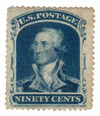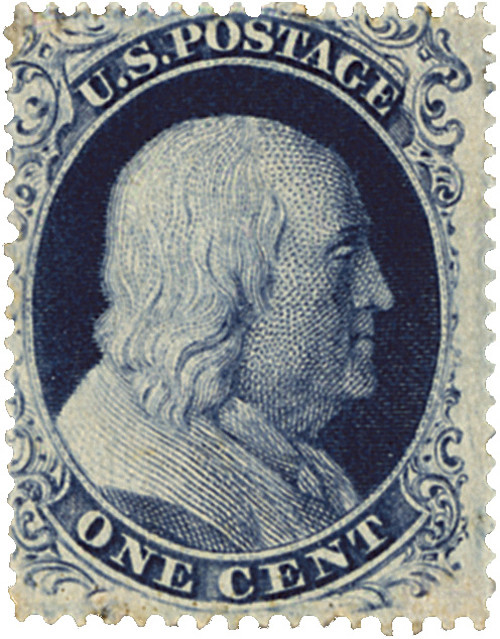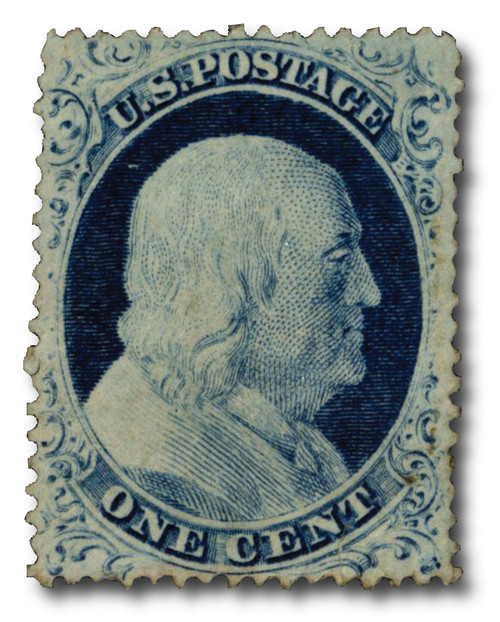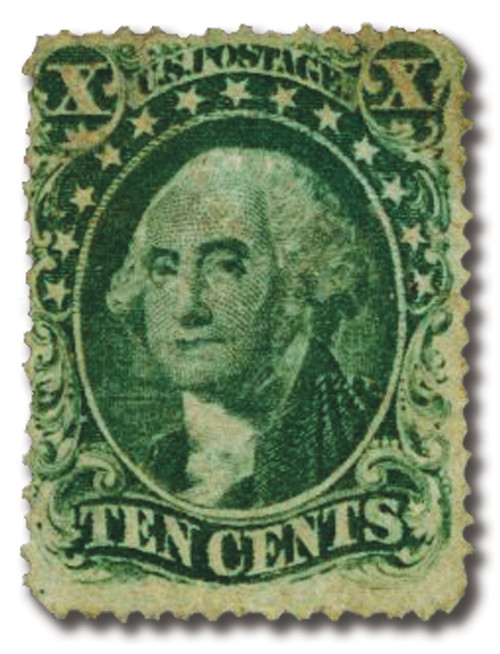
# 39 - 1860 90c Washington, blue
U.S. #39
1860 Washington
- Part of the first perforated series of US stamps
- Used to pay postage on heavier packages to foreign countries, in combination with other stamps
Stamp Category: Definitive
Series: 1857-61 Issue
Value: 90c
Earliest Documented Use: September 11, 1860
Printed by: Toppan, Carpenter & Co.
Quantity printed: 25,000 (estimate)
Format: Printed in sheets of 200 stamps, divided into vertical panes of 100 each
Printing Method: Engraving
Perforations: 15½
Color: Blue
Why the stamp was issued: Though there was no specific 90c postal rate at the time, the Post Office Department requested the denomination for packages needing more postage. The highest denominated stamp issued up to that time, it was used along with stamps of other denominations to make up higher rates. It was most often used on overseas mail, often for heavy packages to China.
Demand for the high-value stamp was expected to be low and relatively few were produced. The high cost (well over $140 today) was too much for many collectors who weren’t able to afford it.
About the printing: The design was engraved on a die – a small, flat piece of steel. The design was copied to a transfer roll – a blank roll of steel. Several impressions or “reliefs” were made on the roll. The reliefs were transferred to the plate – a large, flat piece of steel from which the stamps were printed.
About the design: The image of George Washington in his dress uniform is based on a painting by George Trumbull, a well-known artist of the time. Trumbull created 16 paintings of Washington before he became president.
Special Design Details: The 90c Franklin stamp was originally requested to be printed in pink. However, the printers thought the blue was a much better choice, and the Postmaster General agreed. The stamp is considered by many to be one of the most handsome of the classic period. #39 was voted number ten in the book 100 Greatest American stamps, written by Don Sundman and the late Janet Klug.
About the 1857-61 Series: In July, 1851 – 1c, 3c, and 12c stamps were issued. The new stamps met reduced postal rates passed by act of Congress on March 3 of the same year. Further changes in postage rates appeared in the Act of March 3, 1855, leading to 10c (1855) and 5c (1856) denominations being added to the series. Stamps of the same designs as the 1851-57 Imperforate Series (plus new denominations of 24c, 30c, and 90c) were issued as part of the Series of 1857-61, the first perforated U.S. stamps. The entire series is known for having narrow margins. This is because the perforations took up room normally given to the designs.
U.S. #39 was issued in late 1860, as Lincoln’s inauguration loomed and tensions grew between the North and South. After several Southern states seceded, the federal government announced it would suspend postal service to the new Confederate States of America. Then-current U.S. postage stamps were rendered invalid, including the newly-issued 90¢ Washington stamp. Unsold inventories were returned to the U.S. Post Office and destroyed.
Because they were in use for a very brief period, used examples of U.S. #39 are much rarer today than mint stamps, and command a higher price.
History the stamp represents: #39 was part of the first series of perforated U.S. postage stamps. When the world’s first postage stamps were issued, no provision was made for separating the stamps from one another. Post office clerks and stamp users merely cut these “imperforates” apart with scissors or tore them along the edge of a metal rule. A device was needed which would separate the stamps more easily and accurately.
In 1847, Irishman Henry Archer patented a machine that punched holes horizontally and vertically between rows of stamps. Now stamps could be separated without cutting. Perforations also enabled stamps to adhere better to envelopes. Archer sold his invention to the British Treasury in 1853. That same year, Great Britain produced its first perforated stamps. It wasn’t long before the U.S. decided to make use of the new method of producing stamps with perforations, resulting in the Series of 1857-61.
U.S. #39
1860 Washington
- Part of the first perforated series of US stamps
- Used to pay postage on heavier packages to foreign countries, in combination with other stamps
Stamp Category: Definitive
Series: 1857-61 Issue
Value: 90c
Earliest Documented Use: September 11, 1860
Printed by: Toppan, Carpenter & Co.
Quantity printed: 25,000 (estimate)
Format: Printed in sheets of 200 stamps, divided into vertical panes of 100 each
Printing Method: Engraving
Perforations: 15½
Color: Blue
Why the stamp was issued: Though there was no specific 90c postal rate at the time, the Post Office Department requested the denomination for packages needing more postage. The highest denominated stamp issued up to that time, it was used along with stamps of other denominations to make up higher rates. It was most often used on overseas mail, often for heavy packages to China.
Demand for the high-value stamp was expected to be low and relatively few were produced. The high cost (well over $140 today) was too much for many collectors who weren’t able to afford it.
About the printing: The design was engraved on a die – a small, flat piece of steel. The design was copied to a transfer roll – a blank roll of steel. Several impressions or “reliefs” were made on the roll. The reliefs were transferred to the plate – a large, flat piece of steel from which the stamps were printed.
About the design: The image of George Washington in his dress uniform is based on a painting by George Trumbull, a well-known artist of the time. Trumbull created 16 paintings of Washington before he became president.
Special Design Details: The 90c Franklin stamp was originally requested to be printed in pink. However, the printers thought the blue was a much better choice, and the Postmaster General agreed. The stamp is considered by many to be one of the most handsome of the classic period. #39 was voted number ten in the book 100 Greatest American stamps, written by Don Sundman and the late Janet Klug.
About the 1857-61 Series: In July, 1851 – 1c, 3c, and 12c stamps were issued. The new stamps met reduced postal rates passed by act of Congress on March 3 of the same year. Further changes in postage rates appeared in the Act of March 3, 1855, leading to 10c (1855) and 5c (1856) denominations being added to the series. Stamps of the same designs as the 1851-57 Imperforate Series (plus new denominations of 24c, 30c, and 90c) were issued as part of the Series of 1857-61, the first perforated U.S. stamps. The entire series is known for having narrow margins. This is because the perforations took up room normally given to the designs.
U.S. #39 was issued in late 1860, as Lincoln’s inauguration loomed and tensions grew between the North and South. After several Southern states seceded, the federal government announced it would suspend postal service to the new Confederate States of America. Then-current U.S. postage stamps were rendered invalid, including the newly-issued 90¢ Washington stamp. Unsold inventories were returned to the U.S. Post Office and destroyed.
Because they were in use for a very brief period, used examples of U.S. #39 are much rarer today than mint stamps, and command a higher price.
History the stamp represents: #39 was part of the first series of perforated U.S. postage stamps. When the world’s first postage stamps were issued, no provision was made for separating the stamps from one another. Post office clerks and stamp users merely cut these “imperforates” apart with scissors or tore them along the edge of a metal rule. A device was needed which would separate the stamps more easily and accurately.
In 1847, Irishman Henry Archer patented a machine that punched holes horizontally and vertically between rows of stamps. Now stamps could be separated without cutting. Perforations also enabled stamps to adhere better to envelopes. Archer sold his invention to the British Treasury in 1853. That same year, Great Britain produced its first perforated stamps. It wasn’t long before the U.S. decided to make use of the new method of producing stamps with perforations, resulting in the Series of 1857-61.

















